The Green Wing Macaw and the Scarlet Macaw. These avian wonders, hailing from the vibrant landscapes of Central and South America, captivate with their stunning colors, distinct personalities, and unique characteristics.
As feathered companions or symbols of the wild, these majestic birds stand apart through their size, vocalizations, habitat preferences, and more. Delving into their divergent traits sheds light on the splendor and diversity that nature has crafted within the world of macaws.
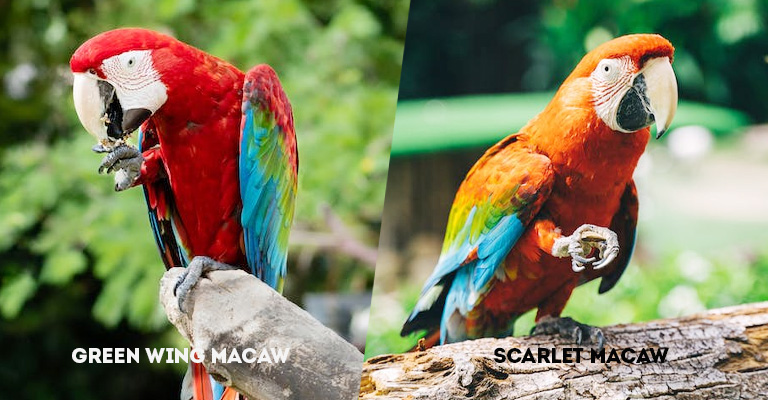
Key Differences Between Green Wing Macaw and Scarlet Macaw
let’s delve a bit deeper into the specific differences between Green-winged Macaws and Scarlet Macaws:
Scientific Name
- Green Wing Macaw: The scientific name of the Green Wing Macaw is Ara chloropterus. This majestic parrot is known for its vibrant colors and large size, making it a popular choice among bird enthusiasts and pet owners.
- Scarlet Macaw: On the other hand, the Scarlet Macaw is scientifically named Ara macao. This strikingly beautiful bird is famous for its vivid red and yellow plumage, making it one of the most recognizable macaw species.
Size
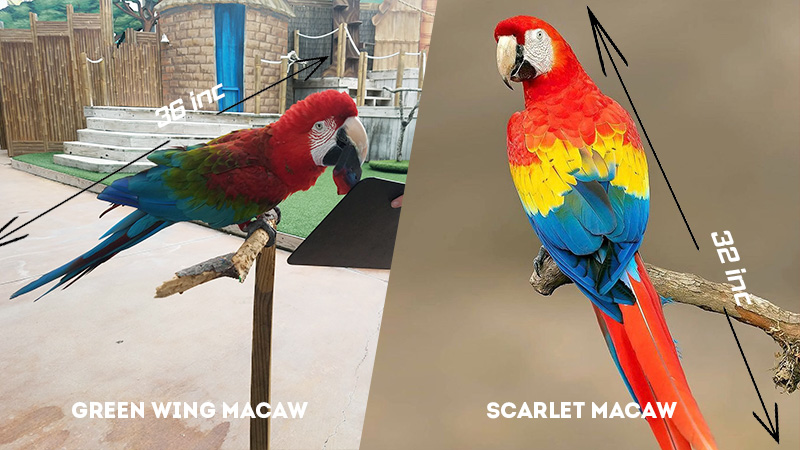
- Green Wing Macaw: When comparing the sizes of these two macaw species, the Green Wing Macaw takes the lead. It is generally larger than the Scarlet Macaw.
With a wingspan that can exceed 3 feet and a length of up to 36 inches, the Green Wing Macaw showcases an impressive and commanding presence. - Scarlet Macaw: The Scarlet Macaw, although slightly smaller than its Green Wing counterpart, is by no means diminutive. With a wingspan of around 2.5 feet and a length of approximately 32 inches, it still possesses a considerable size that demands attention.
Body Color
- Green Wing Macaw: The Green Wing Macaw lives up to its name with its predominantly green body. Its back, wings, and tail feathers are adorned with shades of green, creating a lush and vibrant appearance.
These green hues are often accentuated with patches of blue and red on the wings. - Scarlet Macaw: The Scarlet Macaw, as its name suggests, is famous for its breathtaking red plumage. The majority of its body, including the head, back, and tail, is covered in rich shades of red.
This striking coloration is further complemented by vibrant yellow feathers on its wings and tail base.
Wing Color
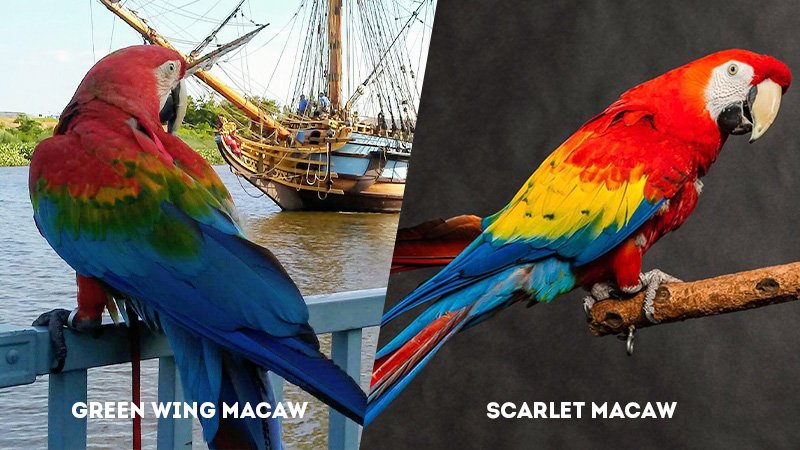
- Green Wing Macaw: The Green Wing Macaw’s wings are primarily green, consistent with its overall color palette.
However, what sets it apart is the presence of distinct blue feathers on the wings, adding an enchanting touch of contrast. The blend of green and blue in its wings creates a captivating visual display. - Scarlet Macaw: In the case of the Scarlet Macaw, its wings showcase a captivating blend of colors. The dominant color is a deep and eye-catching red, which extends to the majority of the wing feathers.
Additionally, vibrant blue and yellow feathers are present on the wings, creating a stunning and harmonious combination.
Facial Patch
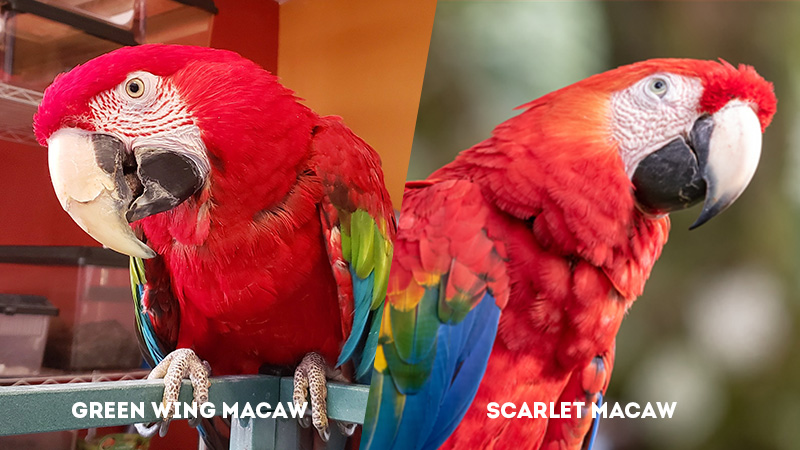
- Green Wing Macaw: One of the distinctive features of the Green Wing Macaw is the white facial patch it possesses. This patch is situated on the face, usually around the eyes.
The contrast between the white patch and the bird’s colorful plumage draws attention to its expressive and intelligent eyes. - Scarlet Macaw: The Scarlet Macaw, in contrast, lacks a distinct facial patch. Instead, its facial area is characterized by bare white skin. This unique feature serves to highlight the bird’s strikingly vivid and contrasting colors, making its appearance even more captivating.
Tail
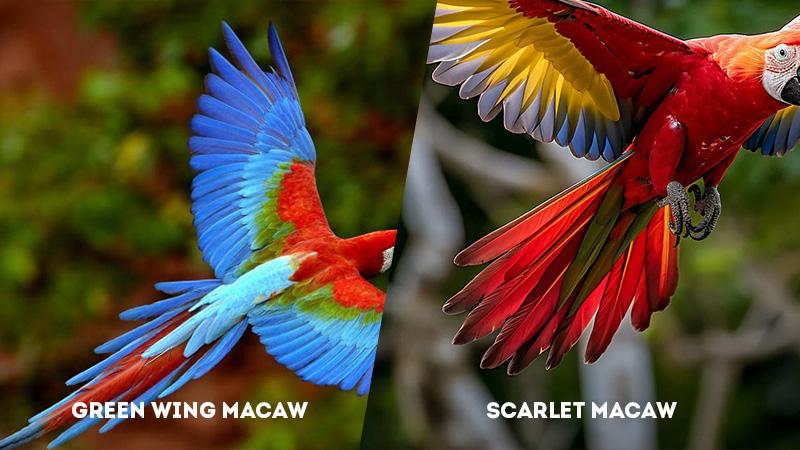
- Green Wing Macaw: The Green Wing Macaw possesses a distinctively colored tail that complements its overall appearance. The tail feathers of this species are primarily green, in line with its characteristic coloration.
The undersides of the tail feathers often showcase shades of blue and red, creating a visually appealing contrast. This colorful tail adds to the bird’s elegance and beauty, especially during flight. - Scarlet Macaw: The tail of the Scarlet Macaw is a prominent feature that contributes to its striking appearance. The tail is predominantly red, matching the bird’s primary body color.
Like the Green Wing Macaw, the undersides of the tail feathers exhibit hues of blue and yellow, creating a harmonious blend of colors. The brilliant red tail feathers make the Scarlet Macaw highly recognizable and sought after.
Lifespan
- Green Wing Macaw: The Green Wing Macaw is known for its relatively longer lifespan among macaw species. These birds can live for an impressive 60 to 80 years under proper care and conditions.
This extended lifespan makes them lifelong companions for those who choose to have them as pets. - Scarlet Macaw: The Scarlet Macaw, while not as long-lived as the Green Wing Macaw, still has a substantial lifespan.
On average, Scarlet Macaws can live for about 40 to 50 years when provided with adequate care, nutrition, and a suitable environment. Their longevity underscores the commitment required in caring for these intelligent and vibrant parrots.
Vocalization
- Green Wing Macaw: Green Wing Macaws are known for their diverse and often loud vocalizations. They possess the ability to mimic a wide range of sounds, including human speech, environmental noises, and other bird calls.
Their vocal talents, coupled with their intelligence, make them engaging and entertaining companions. - Scarlet Macaw: Scarlet Macaws are equally vocal and expressive. They have a vibrant and spirited vocal repertoire, consisting of loud squawks, screeches, and various calls.
While they may not mimic human speech as effectively as some other parrot species, their enthusiastic vocalizations reflect their lively and social nature.
Personality
- Green Wing Macaw: Green Wing Macaws are known for their playful and intelligent personalities. They are curious birds that enjoy interacting with their human companions.
They have a tendency to explore their surroundings and engage in creative activities, making them stimulating and captivating pets. - Scarlet Macaw: Scarlet Macaws are characterized by their affectionate and curious personalities. They are known for forming strong bonds with their owners and thrive on social interactions.
Their playful nature and desire for attention make them delightful companions for those who are willing to invest time in their care and companionship.
Range
- Green Wing Macaw: The natural habitat of the Green Wing Macaw spans across South and Central America. These birds can be found in a variety of environments, including rainforests and woodlands. Their wide distribution allows them to adapt to different habitats and ecological niches.
- Scarlet Macaw: The Scarlet Macaw is native to Central and South America as well. They inhabit diverse landscapes such as forests, savannas, and swamps. Their ability to thrive in various habitats reflects their adaptability and resilience as a species.
Habitat
- Green Wing Macaw: Green Wing Macaws primarily inhabit rainforests and woodlands in their native regions of South and Central America. These lush and diverse ecosystems provide them with abundant food sources and suitable nesting sites.
They are well-adapted to the canopy environments of these habitats, where they can fly freely and forage for food. - Scarlet Macaw: Scarlet Macaws can be found in a range of habitats across Central and South America. They are known to inhabit not only rainforests but also savannas, swamps, and other wooded areas.
This adaptability to different environments allows them to thrive in various ecosystems, utilizing different food sources and nesting sites.
Diet
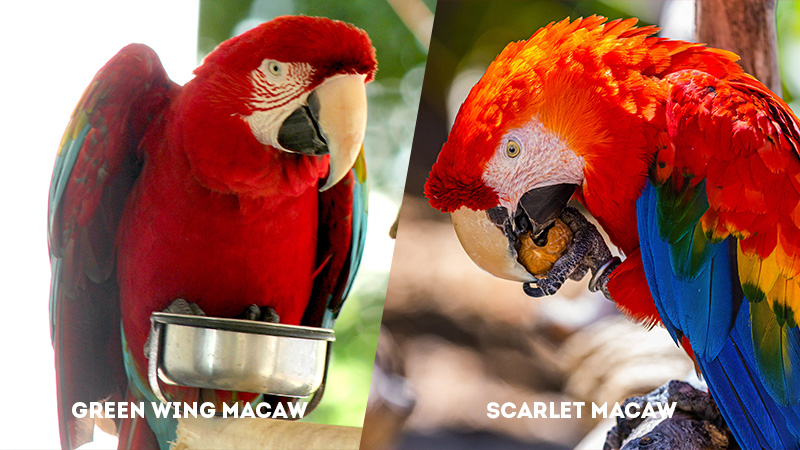
- Green Wing Macaw: The diet of the Green Wing Macaw consists of a variety of foods, including fruits, seeds, nuts, and vegetables. In the wild, they feed on a diverse range of fruits found in their habitat.
Captive Green Wing Macaws should be provided with a balanced diet that mimics their natural food sources to ensure their health and well-being. - Scarlet Macaw: Similarly, the diet of the Scarlet Macaw includes fruits, seeds, nuts, and berries. They are known to have a preference for fruits with tough outer shells, which they crack open with their powerful beaks.
In captivity, a diet rich in fruits and vegetables, along with appropriate supplements, is essential to meet their nutritional needs.
Beak Size
- Green Wing Macaw: The Green Wing Macaw has a relatively larger and more powerful beak compared to some other macaw species.
This beak size is adapted for cracking open nuts, seeds, and tough fruit shells found in their natural habitat. Their beaks also play a role in climbing and manipulating objects in their environment. - Scarlet Macaw: The Scarlet Macaw has a slightly smaller beak compared to the Green Wing Macaw. Their beaks are still strong and well-suited for their dietary habits, enabling them to crack open various food items.
Despite the smaller size, their beaks are effective tools for foraging and exploration.
Iucn Conservation Status
- Green Wing Macaw: The Green Wing Macaw holds a status of “Least Concern” on the IUCN Red List of Threatened Species. While they may face habitat loss and some threats in the wild, their population remains stable and widespread.
- Scarlet Macaw: Like the Green Wing Macaw, the Scarlet Macaw is also classified as “Least Concern” by the IUCN. Although they are impacted by habitat degradation and the pet trade, their populations remain relatively stable across their range.
Feather Patches
- Green Wing Macaw: The Green Wing Macaw typically has fewer feather patches on its wings compared to the Scarlet Macaw. While their wings primarily display green and blue colors, the distinct feather patches are not as prominent as in some other macaw species.
- Scarlet Macaw: The Scarlet Macaw is known for its intricate and captivating feather patches on the wings. The combination of red, blue, and yellow feathers creates a vibrant and visually stunning display. These patches contribute to the bird’s overall beauty and uniqueness.
Price (as Pets)
- Green Wing Macaw: Green Wing Macaws are often considered one of the more expensive macaw species to own as pets. Their large size, vibrant colors, and popularity contribute to their higher price tag.
Potential owners should be prepared for not only the initial cost of acquiring the bird but also ongoing expenses for proper housing, nutrition, and veterinary care. - Scarlet Macaw: Scarlet Macaws are also among the higher-priced macaw species in the pet market. Their stunning red and yellow plumage, along with their captivating personalities, contribute to their demand.
As with any macaw, potential owners should factor in the costs associated with providing a suitable environment and quality care.
Talking Ability

- Green Wing Macaw: Green Wing Macaws are known for their excellent mimicry skills and ability to imitate human speech. They can learn a variety of words and phrases with proper training and interaction.
While not all individuals will become proficient talkers, many Green Wing Macaws can engage in entertaining conversations with their human companions. - Scarlet Macaw: Scarlet Macaws have the potential to mimic human speech, but their talking ability is generally considered more limited compared to some other parrot species.
They are more likely to pick up simple phrases and sounds. However, their vibrant personalities and other vocalizations still make them engaging and interactive pets.
Interaction With Humans
- Green Wing Macaw: Green Wing Macaws are social birds that enjoy interacting with their human owners. They often form strong bonds and can become quite affectionate.
These birds thrive on companionship and mental stimulation, making them well-suited for individuals who can dedicate time to their care and engagement. - Scarlet Macaw: Similarly, Scarlet Macaws are known for their social nature and capacity to form strong bonds with humans.
They enjoy spending time with their owners and can become deeply attached. Regular interaction and positive reinforcement are key to fostering a trusting and loving relationship with a Scarlet Macaw.
Training
- Green Wing Macaw: Green Wing Macaws are generally intelligent and trainable. They can learn a variety of tricks, commands, and behaviors through positive reinforcement training. With patience and consistency, they can become well-behaved and responsive companions.
- Scarlet Macaw: Scarlet Macaws also have the capacity to be trained, though their personalities may vary. They respond well to positive reinforcement techniques and can learn basic commands and behaviors.
Training not only provides mental stimulation but also strengthens the bond between the bird and its owner.
Feather Patterns
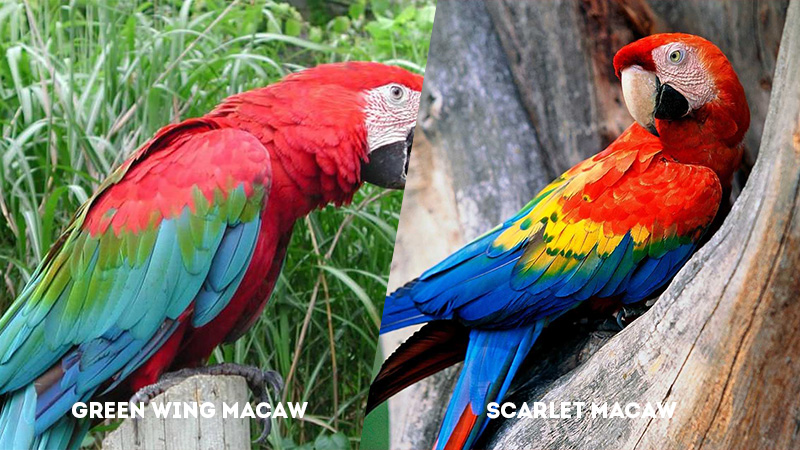
- Green Wing Macaw: The Green Wing Macaw typically has fewer distinct feather patterns on its wings compared to some other macaw species. Their primary wing coloration consists of green and blue hues, with less intricate patterning.
- Scarlet Macaw: In contrast, the Scarlet Macaw is known for its intricate and captivating feather patterns on its wings. The blend of red, blue, and yellow feathers creates a visually stunning display that adds to the bird’s overall beauty.
Green Wing Macaw Vs Scarlet Macaw: Comparison Table
| Feature | Green Wing Macaw | Scarlet Macaw |
|---|---|---|
| Scientific Name | Ara chloropterus | Ara macao |
| Size | Larger | Smaller |
| Body Color | Mostly red and green | Predominantly red and yellow |
| Wing Color | Green wings with blue feathers | Red wings with blue and yellow |
| Facial Patch | White patch on face | Bare white facial patch |
| Tail | Green with blue and red underside | Red with blue and yellow underside |
| Lifespan | About 60-80 years | About 40-50 years |
| Vocalization | Loud and varied | Loud and vibrant |
| Personality | Intelligent, playful | Curious, affectionate |
| Range | South and Central America | Central and South America |
| Habitat | Rainforests, woodlands | Forests, savannas, swamps |
| Diet | Fruits, seeds, nuts, vegetables | Fruits, seeds, nuts, berries |
| Beak Size | Large and powerful | Smaller and curved |
| IUCN Conservation Status | Least Concern | Least Concern |
| Feather Patches | Fewer feather patches on wings | More feather patches on wings |
| Price (As Pets) | Expensive | Expensive |
| Talking Ability | Can mimic human speech | Limited ability to mimic |
| Interaction with Humans | Social, can form strong bonds | Social, can form strong bonds |
| Training | Responds well to training | Responds well to training |
| Feather Patterns | Fewer patterns on wings | More intricate patterns on wings |
Frequently Asked Questions
Yes, Green Wing Macaws and Scarlet Macaws can coexist in the same habitat. While they might compete for resources like food and nesting sites, they generally have overlapping ranges in Central and South America and can share ecosystems like rainforests and woodlands without significant conflicts.
No, neither Green Wing Macaws nor Scarlet Macaws are known to migrate seasonally. They are typically sedentary birds, staying within their respective habitats throughout the year. Their adaptation to various environments allows them to find food and shelter year-round without the need for long migrations.
While both species have been affected by the pet trade, neither Green Wing Macaws nor Scarlet Macaws are currently classified as endangered. However, the illegal pet trade remains a concern, as it can contribute to localized declines in populations and negatively impact their conservation status if not properly managed.
Habitat loss due to deforestation and human development poses a significant threat to both Green Wing Macaws and Scarlet Macaws. Additionally, illegal capture for the pet trade has historically affected their populations. Conservation efforts focus on protecting their natural habitats and enforcing laws against capturing and trading these birds.
While it is theoretically possible for different macaw species to hybridize, Green Wing Macaws and Scarlet Macaws belong to distinct species with differing genetic and physical characteristics. Natural interbreeding between these species is extremely rare in the wild due to their specific behaviors, habitats, and ranges. In captivity, controlled hybridization efforts are sometimes undertaken, but these are not common occurrences.
To Recap
The Green Wing Macaw and the Scarlet Macaw exemplify the breathtaking diversity of the avian world. Through their vibrant plumage, distinct behaviors, and individual quirks, they enchant bird enthusiasts and nature lovers alike.
These macaws, though separate in their traits, share a common thread of resilience as they navigate changing environments and human interactions.
Whether soaring through tropical canopies or brightening households with their presence, their roles as ambassadors of nature’s splendor underscore the importance of conservation efforts and appreciation for the intricate tapestry of life they represent.